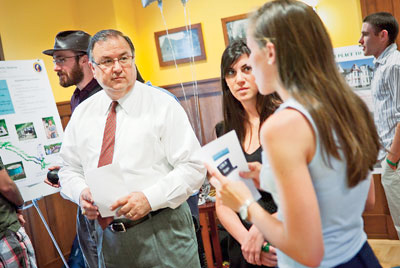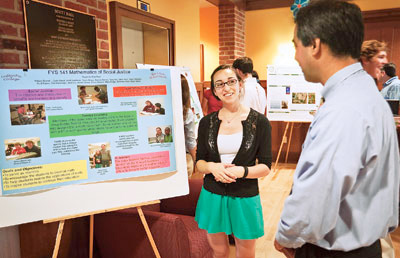Transforming Academic Experiences
by Geoff Gehman ’80 | photography by Chuck Zovko
For Emily Clark ’12, nurturing “green curiosity” in youngsters is a natural extension of her coursework and her co-curricular passion. This spring, she and other members of Lafayette’s Society of Environmental Engineers and Scientists mentored elementary-school children in nearby Bangor, Pa., on topics related to environmental sustainability.
The sessions, held at DeFranco School in Bangor and at Lafayette, focused on alternative energy sources, soil management, water quality, and other themes. “The projects drew on some basic concepts I’ve been taught in the classroom,” says Clark, the president of SEES, a civil engineering major whose focus is on environmental engineering. “They expanded on what the children already knew about the environment and helped them learn new things. Working with the children is very rewarding. I love their enthusiasm!”
The partnership between the College and the Bangor Area School District benefited everybody involved, says Sherri Clifford, director of the district’s state-funded 21st-Century After School Program. When the district received its first state grant to support extra learning opportunities for students and build community partnerships to influence student development and academic achievement, Clifford envisioned building a partnership with Lafayette to create a program of “nurturing green curiosity in young children.”
“We knew Lafayette was really active in the community,” she says, so she reached out to the College and was connected with the members of SEES and the group’s advisers, Arthur Kney, associate professor of civil and environmental engineering, and Steve Mylon, assistant professor of chemistry. “Each time the Lafayette students met with our students, they brought a lesson plan, visual aids, handouts. They took over the teaching. The children loved it, and the teachers were learning new material they could take back to the classroom.”
SEE YOURSELF IN THE LEARNING
Lafayette students and faculty find ways to combine learning with service to the community in courses and scholarship that span the curriculum. Community-based learning and research, also called service learning, involves engaging students in their community, while also utilizing the knowledge they have learned in the classroom.
In the course Single Motherhood, taught by Deborah Byrd, associate professor of English, students do much more than study the myths and realities of pregnant and parenting teens. They tutor, babysit, and donate toys. They provide tips on safety, nutrition, and job training. They give free tickets to college cultural events, yoga lessons, and hope.

SUSTAINABLE FOOD LOOP Emily Clark ’12 (L-R) and Jennifer Bell ’11 are among the leaders of a campus initiative to grow vegetables organically and compost the food waste from dining facilities.
Women’s and Gender Studies 353 could be called Mutual Empowerment 202. The Lafayette students help the young mothers graduate from high school on time. The young mothers inspire the Lafayette students to compile important guides: a cookbook, a child-care manual, a child-care directory. Social-service agents benefit from the undergraduates’ counseling and consoling. And Byrd continues to dovetail her careers as a feminist scholar of Victorian poetry and a mentor to teen moms.
WGS 353 exemplifies community-based learning and research, where the classroom is the community and the community is the classroom. It is becoming a curricular fixture featuring dynamic partnerships on, off, and way off campus. Study-abroad students taught Pennsylvania middle-schoolers about protecting New Zealand’s environment, for example, and engineering students brainstormed designs for a playground, sculpture park, and organic-gardening school at the Metzgar Fields Athletic Complex.
Service learning does much more than support the strategic plan’s call for global citizenship. Students, teachers, and community members get to “test their impressions and ideas, to have debates, to learn about the complexities of the politics of community building,” says Hannah Stewart-Gambino, dean of the College and an organizer of an April expo on experiential education. “The relationship is two-way, so that everyone is engaged in the learning. Once you see yourself in the learning, it makes more sense, it matters more. The light goes on. It’s one thing to study Venice; it’s another thing to study Venice in Venice.”
Service learning revolves around professional, personal challenges. Byrd, for example, started the Single Motherhood project as an extension of her roles as a single mother and a teacher of writing by low-income women. Five years later, she supervises a full-service system with a half-dozen civic agencies, including Easton Area Neighborhood Centers. Her students help teen moms with baby scrapbooks and a college-prep course, a directory of child-care organizations, and pedicures.
Byrd’s program has changed perceptions. Teen moms are inspired by the caring of college students they once dismissed as rich brats, and college students are inspired by the courage of teen moms they once dismissed as welfare princesses.
MUTUALLY EMPOWERING
Like Byrd, Rob Root, associate professor of mathematics, believes that knowledge fosters fairness. His First-Year Seminar The Mathematics of Social Justice, introduced in 2007, is all about boosting equality through quantitative literacy, all about exploring “the distribution of benefits and burdens.” He thinks that students better understand the causes and consequences of the Iraq War if they see the boots of dead soldiers from Pennsylvania on the Quad. They better understand the roots of innumeracy if they follow the quest of Robert Moses, a ’60s civil rights activist, to help young African Americans master algebra to improve their chances of getting into college, getting a good job, and getting ahead.

OUR CITY Sal Panto Jr., mayor of Easton, at the Community-Based Learning and Research Expo. Several projects showcased at the expo involve partnerships in Easton.
Root’s students tutor at-risk middle-schoolers, hoping to interest them in learning the skills they’ll need to prepare tax returns and balance budgets. “It’s not about being a math educator,” says Root, who has taught math and social justice to other professors. “It’s about finding ways to motivate kids who are on the ledge of leaving behind mathematics to persevere. It’s about making college students learn more by learning more about what the kids care about.”
Root helped spur Alyssa Smith ’11 to create her own major, quantitative literacy and social justice. As a tutor and a community volunteer, she’s learned that poor math and reading scores can be attributed to poor role models and teachers with low expectations of low-income families. Smith wants to become a public-policy reformer “to make math more than just an abstract world of numbers, to make it a tangible, mutually empowering experience.”
For his market-research course, Christopher Ruebeck, associate professor of economics, was looking for an engaging assignment. He found a suitable client in Lynn Prior, coordinator of an area branch of Buy Fresh Buy Local. She wanted to know what would convince more of her constituents to purchase healthier food grown closer.
Assisted by undergraduates at Muhlenberg College, Ruebeck’s students polled farmers, grocery-store owners, restaurateurs, and campus consumers. Non-students, they discovered, care more about taste, while students care more about convenience. These conclusions, along with Ruebeck’s proposals, are posted on the web site of the Lehigh Valley Research Consortium, a scholarly forum encompassing health insurance, gambling, and other issues.
REWARDING AND CHALLENGING
The Buy Fresh Buy Local project opened the senses of Sarah Christy ’10, who helped Ruebeck prepare the survey. “In some classes, you know nothing is really going to come of your research,” says the economics and business graduate. “In this class, you felt much more connected and invested, knowing that what you found was actually going to be used to help the community.”

MATH AND SOCIAL JUSTICE Dena Inqui ’13 and her classmates in a First-Year Seminar helped Easton middle-school students understand applications of math concepts outside the classroom.
Last spring, Christy and her peers joined 19 other campus-community teams during the College’s first expo on experiential education. There were presentations on helping low-income Easton residents prepare tax returns and designing a cultural center for Easton’s West Ward. Students in a documentary film course taught by Andy Smith, assistant professor of English, screened a short film about Third Street Alliance for Women and Children, a full-service center in Easton. Byrd and her Single Motherhood partners spoke of helping older mothers in the alliance’s shelter recover from divorce, imprisonment, and other traumas.
Pleased by a day of networking, Byrd still insists that service learning needs more support, financial and otherwise. The Single Motherhood project, she points out, is expensive; her students have to sell donated pizzas to pay for materials for baby scrapbooks. It’s unpredictable; funding cuts forced Easton Area High School to close its daycare center for the children of teen moms. And it’s under-valued by some as mere charity.
“There are still some people who think service learning is just about being a good citizen, a do-gooder,” says Byrd. “They don’t believe that it can be socially rewarding and intellectually challenging at the same time, that a child-care directory can be as important as an article in a refereed journal.”